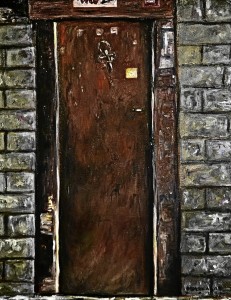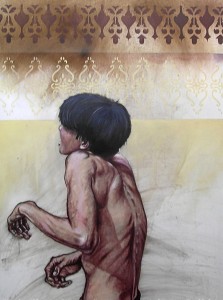
In New York City last week, a pair of Filipino artists opened a joint exhibit at the Philippine Center right smack on Fifth Avenue.
From the complexly constituted motherland of pain that is Mindanao today—the Southern Philippine stronghold of hunger and poverty, wars and rebellions, kidnappings and massacres and tribal vendettas—spring forth two visual artists whose works resonate with the eloquence of hope.
To be sure, Errol Balcos’ portraits of ordinary people in contortions of agony detail, and therefore magnify, the intensity of their suffering. Tapping the usual armaments of his art (oil, acrylic), he renders with brutal bluntness the motions and emotions of the Mindanao people as they internalize the structural degradation of their human dignity.

These portraits, seemingly artless in the artist’s attempt to hew to the integrity of moral verisimilitude, mesmerize with their skilful simplicity that succeeds not just in evoking presence but also in engaging presences: Despite yourself, you find yourself drawn into the picture in search of milieu and meaning.
Balcos’ works on display here—a quiet bravura of vigor and vitality that allows us to hear the gnawing and the growling within—remind us of Joseph Conrad’s pronouncement that the true test of art is not beauty but power.
An artist-fellow of the New York-based Asian Cultural Council, Michael Bacol’s evocations of children and doorways, on the other hand, whisk us off from the poignant cry of Social Realism to the cryptic landscape of the symbolic. In this series of paintings, are we to be guided by the artist’s admission that his childhood—perhaps, even his whole life—was spent in search of his father?

The artist says his father left his mother when he was two, and when he began to look for his father, his mother would reply: “He drowned in the soup.”
As it happens, families lose their loved ones in Mindanao because Mindanao has become a multicultural melting pot of grievances—and violence has necessarily become the language of the dispossessed, the alienated. Far from the corridors of power, a number of people in Mindanao have turned to bloodshed as a way to air their grievances, or suppress others’ complaints, or avenge their misfortunes.
The children Bacol presents in his works seem lost in this mind-boggling soup: They seem bereft of fatherly and motherly care, and appear to be burdened by the great need to be happy.
Bacol juxtaposes these images of children with depictions of doors, both enigmatic and holding promise. By so doing, he seems to suggest that the way out of suffering is to open doors of possibility and embark on other journeys. Who knows? In his journey of growing up, the child will become a father: He will be his own answer. (Whether that is a good thing or not is another story.)
Be that as it may, in the motherland of pain that is Mindanao today, taking a hard look at the roiling emotional landscapes with brutal bluntness or with symbolic wishful thinking is one big step of hope in the shared, continuing passage of humankind.
The exhibit, which runs until May 4, is open to the public free of charge. It is sponsored by the Nursing Office/Dolores: The Colors of Pain. The Philippine Center is at 556 Fifth Ave. in Manhattan.
The author is an artist-fellow of the Asian Cultural Council in New York.

